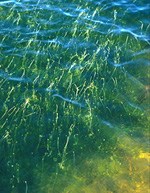 |
This is a small, cosmopolitan family of submerged aquatics usually found in saline (sometimes hypersaline) water in salt lakes, estuaries and seacoasts. It occurs around most of Australia.
Characteristic features of the family Ruppiaceae in Australia include: - submerged seagrasses with very slender, linear, thin-textured leaves with toothed apices and prominent sheathing bases
- flowers small with no recognizable perianth, borne in small, 2-flowered spikes enclosed by the sheathes of upper leaves, but after pollination the inflorescence stalk elongating and often becoming spirally coiled
- stamens 2 per flower, with sessile anthers
- carpels 4 or more, free; fruit a small, hard nutlet borne on a long stalk
Description
Annual or perennial freshwater or marine aquatic herbs rooted in the substrate with their leaves all or mostly submerged. Perennating by rhizomes or turions (a short, condensed shoot, filled with starch). Vegetative reproduction by rhizomes or turions. Stem internodes terete, or oval, or slightly flattened. Internal secretions not obvious. Plants glabrous. Leaves distichous, or apparently opposite, cauline or rarely all or mostly basal, sessile or apparently petiolate. Stipule-like lobes absent. Lamina simple, symmetric, filiform, acicular, subulate or linear; base attenuate, or lobed, or auriculate; margins entire or serrate, ±flat; venation parallel, with the midrib conspicuous or inconspicuous, and the tertiary venation not reticulate; surfaces not punctate; herbaceous, membranous or papery. Leaf ligule absent. All the flowers bisexual. Inflorescences terminal or apparently axillary, consisting of spikes. Spathes present. Bracts present. Pollination by water. Flowers odourless, sessile. Floral disc present or absent; nectaries absent. Perianth absent. Fertile stamens 2 or apparently 4, distinct from each other or grouped or fused into bundles, apparently paired. Staminal filaments absent. Anthers not versatile, opening outwards by longitudinal or transverse slits, 1–2-celled; appendages absent or apical. Ovary superior and sessile. Carpels (2–) 4–12 (–16), free from each other. Style terminal, single and unbranched. Ovules 1 per carpel; placentation basal. Fruit a dry indehiscent nut, or a fleshy drupe. Disseminule micro-surface ±smooth, green or brown, dull. Seeds 1 per fruit. Aril absent. Cotyledons 1. Embryo straight.
(Note: this description has been generated from the coded data compiled for the key. Any errors in the key data will be reflected in the descriptions.)
A treatment of the family Ruppiaceae has not yet been published in the Flora of Australia. It will appear in Volume 39.
Australian genera of Ruppiaceae (as recognised for the Flora of Australia)
Ruppia

|
  |

Ruppia tuberosa (habit)
Photo: S.Jacobs © S.Jacobs
|
 |
|